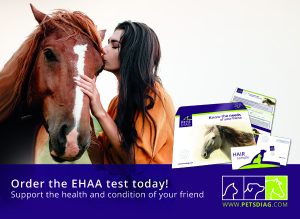 An elemental hair analysis in which a hair sample is tested for nutrient and detrimental, heavy metal content; it’s a test used in humans to detect potential health problems long before any symptoms appear. This effective and non-invasive test can also be done in horses – thanks to a collaboration between the Lifeline Diag laboratory and the University of Agriculture in Krakow, which developed elemental hair analysis of the mane – EHAA.
An elemental hair analysis in which a hair sample is tested for nutrient and detrimental, heavy metal content; it’s a test used in humans to detect potential health problems long before any symptoms appear. This effective and non-invasive test can also be done in horses – thanks to a collaboration between the Lifeline Diag laboratory and the University of Agriculture in Krakow, which developed elemental hair analysis of the mane – EHAA.
Elements are part of every living organism, and their correct levels and mutual proportions are responsible for the proper functioning of the body. Minerals participate is many physiological and biochemical processes, and have many important functions, including regulating muscular function, the nervous system, and metabolism, and are a building material for bones and soft tissues. They’re key in the process of synthesising many vitamins, hormones and protein-building compounds, including amino acids. Unfortunately, a horse doesn’t make them, and so they must be provided with food and, importantly, in the right amount. A mineral deficiency causes many disorders and health problems, and an excess is also very detrimental. That’s why it’s so important to check the level of individual elements in the body, including in horses. The diet impacts almost every aspect of a horse’s life, determining its overall quality. The skin, hooves, coat, as well as immunity, breeding activity and smooth functioning of all processes taking place in the body all depend on its biochemical process needs being met.
How can you know the needs of your horse? How can you check if you’re providing it with everything it needs to enjoy good health and form? It’s not simple, especially since a deficiency in some elements can’t be seen with the “naked eye”. Often, like for example in the case of chromium, deficiency symptoms are not even fully understood. Unfortunately, the absence of strong signals in the body doesn’t mean that it’s not lacking an element, which in the case of, for example, chromium, can lead to a disturbance in metabolic processes and insulin action, as well as a decline in endurance and resistance to stress.
What’s more, the need for macro- and microelements is not the same for all horses. Even in one horse, it’s not constant and fluctuates periodically due to internal and environmental factors. A horse’s need for nutrients depends on:
– age, sex and breed – this is different in stallions, mares, geldings, and different again in foals and young horses;
– the level of physical activity and training intensity – depending on whether you’re dealing with a recreational, working or sport horse;
– the breeding season – in stallions with an intensive mating programme, the need increases by up to 20%;
– pregnancy or lactation – the need for minerals is greater in pregnant mares during the building of the skeleton of the foetus, and immediately after delivery in connection with the production of colostrum and milk;
– the general form of the body, and current or past diseases;
– the time of year and temperature of the environment.
 An assessment of the biochemical needs and to what degree they’re met is, therefore, not easy, but it is possible. The form, tendency to disease and individual nutritional needs of the horse will be shown in the results of a mane analysis – the EHAA – which shows the level of macro- and microelements, as well as the concentration of toxic elements that inhibit nutrient absorption. Mineral excesses and deficiencies as well as the heavy metal burden on the body not only cause many diseases and ailments, but also make their treatment difficult.
An assessment of the biochemical needs and to what degree they’re met is, therefore, not easy, but it is possible. The form, tendency to disease and individual nutritional needs of the horse will be shown in the results of a mane analysis – the EHAA – which shows the level of macro- and microelements, as well as the concentration of toxic elements that inhibit nutrient absorption. Mineral excesses and deficiencies as well as the heavy metal burden on the body not only cause many diseases and ailments, but also make their treatment difficult.
What is EHAA?
EHAA is an effective and non-invasive diagnostic test that provides a picture of the patient’s biochemical balance, which is the state of their health. The test determines the level of 21 elements in the horse’s body. It helps detect many health problems, and defines the crucial proportions between elements, enabling the elimination of dietary mistakes and the introduction of beneficial changes to the diet. There’s also a test description that comes with the results – it shows the possible consequences of the specific mineral deficiencies and excesses, and recommends how to restore balance in the horse’s body. Thanks to this, the EHAA allows you to find and counteract many diseases when they’re in the pre-symptomatic stages of development in the body.
The test is carried out using the ICP-OES technique – inductively coupled plasma optical emission spectrometry on the Avio 200 PerkinElmer spectrometer. The reference values that the elements in the test refer to have been developed for the needs of EHAA by a research team at the University of Agriculture in Krakow and are based on in-depth comparative research. The EHAA results have a description section prepared based on reports by university employees. The information it contains provides a better understanding of the EHAA results and allows you to introduce the right changes to the diet of the horse being tested. The description section contains several chapters.
First of all, we learn about the state of the skin, coat, joints, muscles and hooves. We also obtain information about the horse’s form and immunity, as well as about the functioning of its digestive system, breeding activity, and in the case of foals, the correctness of their growth, and even temperament and behaviour. Details about the level of minerals specified in the EHAA results make all this possible.
If you want to learn more about EHAA analysis for horses, read the next part of the article. You’ll soon find the article at: www.petsdiag.com / Publications.

Kamila Kaczmarkiewicz-Dudek (Pets Diag), EHAA – a test worth doing. HODOWCA i JEŹDZIEC, spring 2021, pp. 50-54.












 An assessment of the biochemical needs and to what degree they’re met is, therefore, not easy, but it is possible. The form, tendency to disease and individual nutritional needs of the horse will be shown in the results of a mane analysis – the EHAA – which shows the level of macro- and microelements, as well as the concentration of toxic elements that inhibit nutrient absorption. Mineral excesses and deficiencies as well as the heavy metal burden on the body not only cause many diseases and ailments, but also make their treatment difficult.
An assessment of the biochemical needs and to what degree they’re met is, therefore, not easy, but it is possible. The form, tendency to disease and individual nutritional needs of the horse will be shown in the results of a mane analysis – the EHAA – which shows the level of macro- and microelements, as well as the concentration of toxic elements that inhibit nutrient absorption. Mineral excesses and deficiencies as well as the heavy metal burden on the body not only cause many diseases and ailments, but also make their treatment difficult.

